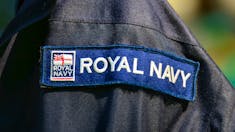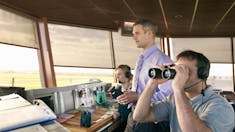RAF Defence Aptitude Test - 2025 Guide with Practice Questions
All products and services featured are independently selected by WikiJob. When you register or purchase through links on this page, we may earn a commission.
- What Is the AST RAF Aptitude Test?
- What Does the AST RAF Aptitude Test Consist Of?
- Which Question Formats Can You Expect to See for AST RAF Test?
empty
empty
empty
empty
empty
empty
empty
- What to Expect When Taking the AST RAF Aptitude Test in 2025
- What Else Does The AST RAF Recruitment Process Include?
empty
empty
empty
empty
empty
empty
empty
- Tips on how to Pass and Prepare for Your RAF AST in 2025
- RAF Aptitude Test Pass Mark or Score Requirements
- What’s Next for RAF Aptitude Test?
- Frequently Asked Questions
- Final Thoughts
If you’ve thought about applying to join the Royal Air Force (RAF), you may be aware that you will be required to pass an aptitude test before being accepted.
The RAF relies on a highly skilled and able body of recruits to function as one of the world’s leading military air forces.
To ensure the highest calibre of employees, it requires that every applicant passes the aptitude test before progressing in the process.
The test is also sometimes referred to as the Airman/Airwoman Selection Test or AST.
What Is the AST RAF Aptitude Test?
The RAF is an enormous organisation with many different departments and specialities that work together for a collective outcome.
The RAF aptitude test assesses the strengths and weaknesses of every applicant to identify a department or role that suits their skill set and capabilities.
Of course, full training will be given, and the test assumes no prior experience.
It instead focuses on natural talent, innate intelligence and certain personality traits to evaluate your suitability for the various roles available.
The better you do on your test, the more career options will open up to you, so it’s worth pushing yourself to excel in every area you can.
Before taking the RAF aptitude test, you will need to check your eligibility to apply, which you can do at raf.mod.uk.
What Does the AST RAF Aptitude Test Consist Of?
The RAF (Royal Air Force) Aptitude Test is a multifaceted assessment designed to evaluate cognitive abilities crucial for diverse RAF roles.
It includes sections assessing mathematical reasoning, verbal proficiency, spatial awareness, and problem-solving. Tailored components may be included for specific job roles, ensuring candidates possess both general aptitude and specialized skills.
The test aims to select individuals with the potential to excel in the dynamic and challenging environments of the Royal Air Force. Aspiring candidates can enhance their preparation by familiarizing themselves with the test components and honing skills relevant to their desired RAF career path.

Which Question Formats Can You Expect to See for AST RAF Test?
The AST consists of seven different tests, all presented in multiple-choice format.
Let’s outline the seven test types and on which skills they focus:
1. Verbal Reasoning
Verbal reasoning assesses your ability to understand and analyze written information. You will be presented with passages of text and asked to answer questions based on the information provided.
This test consists of 20 questions with a time allocation of 15 minutes. It is designed to test your ability to understand and interpret written information.
Practice Question

1. Read the above poster which is on the wall of a holiday cottage in Devon.
Which of the following statements is incorrect?
a) The occupiers must empty the house bins before they leave
b) Free unlimited WiFi is available
c) Guests must keep noise to a minimum
d) The refrigerator must be left empty at the end of the stay
2. Numerical Reasoning
Numerical reasoning evaluates your numerical and mathematical abilities. You will be presented with data, graphs, charts, or mathematical problems and asked to solve them using basic arithmetic, percentages, ratios, and other mathematical concepts.
This test is split into two parts. In part one, you have four minutes to answer 12 questions, and in part two, you have 11 minutes to answer 12 questions.
This test assesses your ability to interpret numerical data. The data may be presented in various numerical formats, such as graphs or charts, and will vary in difficulty.
Practice Question
| 1 week | 2 weeks | |
|---|---|---|
| France | £750 | £1,450 |
| Spain | £520 | £720 |
| Italy | £800 | £1,320 |
| Greece | £460 | £790 |
Above is a holiday price list. Prices are per person.
2. Jason wants to take his mother away on holiday. He wants to spend one week in Italy and one week in France.
What would the total cost be?
a) £3,000
b) £3,100
c) £1,550
d) £2,770
Practice RAF Aptitude Test with JobTestPrep
3. Work Rate
Work rate evaluates your ability to process information quickly and accurately. You will be presented with sets of questions or tasks that need to be completed within a specific time frame.
This test assesses your speed and accuracy of working. The applicant has four minutes to answer 20 questions.
Practice Question
| 9 | 5 | 2 | 4 |
| G | L | M | X |
| ! | + | * | ~ |
3. Which could be a possible code for 459?
a) 259
b) XLG
c) X+L
d) *+!
4. Spatial Reasoning
Spatial reasoning assesses your ability to mentally manipulate and visualize objects in space. You will be presented with 2D and 3D shapes, patterns, or diagrams and asked to identify rotations, reflections, or spatial relationships.
The spatial reasoning test is split into two sections.
Part one focuses on how well you can visualise how shapes fit together. You have four minutes to complete ten questions.
Part two assesses your ability to imagine 3D shapes from all angles and allocates three minutes to answer ten questions.
Practice Question
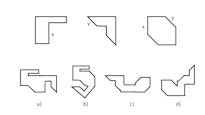
4. Which shape is formed when the three shapes at the top are joined together as per the labels shown?
5. Electrical Comprehension
In this test, candidates have 11 minutes to answer 21 questions based on the electrical information taught during the GCSE physics curriculum.
Some questions will be written and some will be visual; for example, showing a circuit board with associated symbols.
You will need to know the common electrical symbols; for example, a switch, a battery and a fuse.
Practice Question
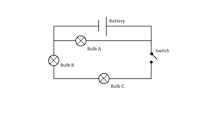
5. What will happen when the switch is closed?
a) Bulb A will light up
b) Bulbs B and C will light up
c) None of the bulbs will light up
d) All of the bulbs will light up
If you need to prepare for a number of different employment tests and want to outsmart the competition, choose a Premium Membership from JobTestPrep.
You will get access to three PrepPacks of your choice, from a database that covers all the major test providers and employers and tailored profession packs.
6. Mechanical Comprehension
Mechanical comprehension measures your understanding of mechanical and physical principles. You will be presented with diagrams or descriptions of mechanical systems and asked to answer questions related to how the systems work, how forces interact, or how objects move.
This test allows you 10 minutes to answer 20 questions, testing your understanding of mechanical concepts.
Practice Question
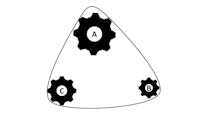
6. If cog A starts rotating, which of the cogs will have the fastest rotation speed?
a) Cog A
b) Cog B
c) Cog C
d) All of the cogs will rotate at the same speed
7. Memory
Finally, you will sit a two-part memory test which consists of 10 questions in video format, testing your recall and memory.
Part one asks you to memorise sequences of letters.
Part two tests your ability to remember visual patterns.
Once you have seen the video, you will be asked questions to test your recall.
Practice Question
You may be shown the following (each letter will appear on the screen one at a time):
A, X, L, Z, F, U
After the letters have been removed from the screen, you will be asked a question.
How many letters are there in between A and L?
What to Expect When Taking the AST RAF Aptitude Test in 2025
You will sit the RAF aptitude test at your nearest Armed Forces Careers Office (AFCO), of which there are several across the UK.
You must bring photographic ID with you, such as a passport or driving license, to be allowed to sit the test.
You are not permitted to use a calculator or dictionary, but you will be provided with a pencil and paper to work out your answers in the Numerical Reasoning test.
You are required to dress smartly for your AST (women are advised to wear low heels).
The AST will take around 90 minutes in total to complete, which is a tight time frame. Don’t panic if you don’t manage to complete all the questions, as the RAF advises that very few people do.
Your test will be invigilated by RAF Career Officers.
What Else Does The AST RAF Recruitment Process Include?
The recruitment process for the Royal Air Force (RAF) typically includes several stages to assess candidates' suitability for various roles within the organization.
While the specific details may vary, here is an overview of the RAF recruitment process:
RAF Initial Application
The process begins with an online application where you express your interest in joining the RAF. You will provide personal information, educational background, and details about your career preferences.
RAF Aptitude Tests
If your initial application is successful, you will be invited to complete a series of aptitude tests.
These tests assess your abilities in areas such as verbal reasoning, numerical reasoning and mechanical comprehension. The specific tests may vary depending on the role you are applying for.
RAF Recruitment Presentation
After passing the aptitude tests, you may be invited to attend an RAF recruitment presentation.
This session provides detailed information about the RAF, its various career opportunities and the selection process.
You will have the opportunity to ask questions and gain a better understanding of what the RAF expects from its candidates.
RAF Medical Assessment
Candidates who progress further in the recruitment process will undergo a comprehensive medical assessment.
This assessment ensures that you meet the medical standards required to serve in the RAF.
It includes a physical examination, hearing and vision tests and a review of your medical history.
RAF Fitness Test
As part of the selection process, candidates must undergo a comprehensive fitness test to assess their physical capabilities per the Royal Air Force's standards.
The test typically includes running for cardiovascular endurance, push-ups and sit-ups for upper body and core strength, and a grip test for hand and forearm strength. Meeting these fitness standards is crucial to ensuring candidates are physically prepared for the challenges associated with various RAF roles.
In addition, adequate preparation, including cardiovascular and strength training, is recommended to enhance performance in the fitness assessment and overall readiness for an RAF career.
RAF Interview
If you pass the previous stages, you may be invited for an interview with an RAF officer.
The interview aims to assess your motivation, personal qualities, and suitability for a career in the RAF.
Be prepared to discuss your background, skills and aspirations, as well as demonstrate your knowledge of the RAF and the role you are applying for.
RAF Security Checks
Before final selection, you will undergo security checks to ensure your suitability for military service.
These checks include background checks, security clearance and references.
Tips on how to Pass and Prepare for Your RAF AST in 2025
The RAF aptitude test is assessing your cognitive ability and thought processes, but don’t rely on coasting through it using your natural ability. There are ways you can prepare.
Taking these tests can prove to be nerve-wracking, so good preparation will help you stay calm on the day and perform at your best.
Step 1. Complete Practice Papers
By far, the best way to prepare for your RAF aptitude test is to complete practice papers and test questions as much as possible.
As well as training your mind to respond to the types of questions and images presented to you, this will also prevent you from getting any unwelcome surprises on the day.
The questions above are a small sample of what you can expect to see.
Please note that the examples here are of low difficulty, but the questions in the live tests will be of varying degrees of difficulty.
Step 2. Get Prepared Early
Leave yourself plenty of time to prepare and, on the day itself, arrive at your test centre early to avoid last-minute stress.
Step 3. Practice Under Timed Conditions
Make sure you are familiar with the format of the tests and have practised staying within the allotted time frame.
The 90 minutes will go quickly, and if you have practised under timed conditioned, you will be less flustered by this.
Step 4. Identify Your Weaknesses
Focus on the areas you find the most challenging. If you know you will find the Spatial Reasoning test difficult, focus on this in your practice.
The more comfortable you are even with the difficult questions, the more likely you are to perform well on the day.
Step 5. Manage Nerves and Stress
Being up against the clock can be stressful, but as with any exam, good preparation and remaining calm will help you keep your cool.
Step 6. Practice at Home
Practice basic maths at home and try reading a newspaper article then asking someone to question you on it to test your understanding and recall.
RAF Aptitude Test Pass Mark or Score Requirements
The RAF does not publish a specific pass mark. They are instead looking to discover your strengths and abilities in each area to determine roles you would be most suited to.
A technical job, such as an aircraft engineer, requires a higher pass score (especially in technical questions) than would be needed by a physical trainer, for example.
Immediately after the test finishes, you will be able to leave the test centre for a break, while your test is marked.
You will then meet with a recruiter on the same day to discuss the next steps, depending on how you scored. This is known as ‘trade counselling’.
Keep an open mind about which path is right for you as the test can sometimes indicate that you are particularly well suited to an area that differs from the trade for which you originally applied.
You will have the chance to discuss the various trades on offer and what they entail.
If you score highly on the AST, you will be offered a selection of career paths from which to choose.
If you score lower than you had hoped on the aptitude test, all is not lost.
Although you may not qualify to train in the area you first chose, you may be offered alternative training in an area that does not rely on high test scores. Your local centre can discuss this with you if relevant.
If you fail the AST, you will be given a second chance to take it, but if you fail a second time, you may be required to wait a significant amount of time (years) before you can retake it.
What’s Next for RAF Aptitude Test?
Once you have the results of your test, you will have a clearer idea of which paths you can take within the RAF. If you are successful in passing the aptitude test, you will be invited to an interview.
The interview will take place either at the Air Force Careers Office you took your test or at a selection centre.
The interviewer will recap the information you provided in your application and will enquire further as to why you wish to join the RAF and why you will make a good candidate.
Be yourself during your interview – your interviewer will see through any bluffing or bravado and will view it unfavourably. This is your chance to get to know your recruiter and what working in the RAF entails.
To be considered as an RAF recruit, candidates are also required to pass a standard basic fitness test, usually consisting of a running assessment and simple strength exercises like press-ups and sit-ups; be sure to train for this before applying.
Frequently Asked Questions
The RAF aptitude test is known as the Airman Select Test (AST), and it consists of seven different types of questions, all designed to assess the natural talent and inherent competencies of potential recruits.
It is used for assessing people who have applied for non-commissioned personnel roles. The sections in the multiple-choice test include:
- Verbal Reasoning
- Numerical Skills
- Work Rate
- Spatial Reasoning
- Electrical Comprehension
- Mechanical Comprehension
- Memory
The assessment takes place at an Armed Forces Career Office (AFCO) and takes about 90 minutes to complete, and the results will help the RAF Career Officers to determine what role would best fit your skills and competencies.
There is a minimum required score to be considered for each trade within the RAF, and the scores are not published.
If you do not achieve the required score, you might be offered the opportunity to undertake training for a different role.
However, you can resit the assessment – but only once. It can take years for you to be able to resit the AST a third time.
If you do not achieve the required score for your preferred trade in the RAF, you can resit the Airman Selection Test (AST).
You will only get one extra chance – if you fail a second time, you will have to wait a large amount of time to be able to resit. It could be years before you will be considered again.
The RAF Airman Selection Test (AST) is a psychometric assessment that is designed to evaluate your thought processes and cognitive abilities, and as such, there is no need for any previous knowledge of the role for which you have applied.
However, one of the most important things you can do to prepare for the test is to take practice assessments.
When you complete practice tests, under relevant exam conditions, you are getting familiar with the test structure and the type of questions you will face – and you are also learning about what areas of the assessment you might need to focus your revision on.
Refreshing your memory about the core teachings of GCSE Physics will help you ace the mechanical and electrical sections of the test. You might want to revise basic mathematical operations and how to deal with percentages and fractions for the numerical part. Practice and revision will give you the best chance to demonstrate that you have what it takes for the role you have applied for in the RAF.
In the lead-up to the assessment, make sure that you get a good amount of sleep so you are well-rested, and eat a good, healthy breakfast on the day. Arrive at the test center in suitable time, smartly dressed and with the right ID and other documentation that you have been told to bring so that you aren’t rushing and getting flustered before you even get into the test center.
The RAF does not publish the required scores for each role they hire for. It is generally accepted that the more technical or advanced the non-commissioned role, the higher you will need to score in the AST.
This is also true of roles that might have more competition or are more popular with potential recruits – you will have to beat other applicants to be considered in this case.
Achieving a high score will mean that you are given more opportunities for roles, while a lower score might make you only suitable for certain roles.
You will find out the results of the AST on the same day – an RAF Career Officer will be there to advise you and provide what is known as ‘Trade Counselling,’ which is a discussion about the types of roles that your score shows you are capable of.
There are seven sections in the RAF aptitude test (AST), and every question is structured to have multiple choice answers. The sections are ordered as follows:
- Verbal Reasoning – 20 questions to be answered in 15 minutes, based on written information.
- Numerical Reasoning – This is split into two parts. Part one has 12 questions to be answered in four minutes, and part two has 12 questions to be answered in 11 minutes.
- Work Rate – This section is about your speed and accuracy, with 20 questions to be answered in just four minutes.
- Spatial reasoning is split into two parts as well, with the first on shape visualization lasting four minutes and containing 10 questions. The second part is about 3D shape visualization, and you will have only three minutes to answer 10 questions.
- Electrical Comprehension – Based on GCSE-level electrical knowledge from the Physics curriculum, you will have to answer 21 questions in 11 minutes.
- Mechanical Comprehension – More physics knowledge is assessed here, using everyday mechanical objects and concepts. There will be 20 questions to be answered in 10 minutes.
- Memory – This is a video section, where you will have to answer 10 questions based on your ability to memorize both letter sequences and visual patterns.
There are several different ways you can practice for the RAF aptitude test (AST) online.
First, there is a comprehensive mock test available on the RAF Careers site, which is designed to be as close as possible to the real thing. Other test sites provide example questions that are like the style of question asked in the AST, such as this article.
If you are looking for more resources to improve your score, then you could consider purchasing an AST Prep Pack from JobTestPrep, as this also includes revision materials and top tips as well as several practice tests.
One of the best sources of information about what to expect when you take the RAF aptitude test (AST) is the RAF careers website.
This is full of details about the application process, what the test center will be like, and has a mock exam that you can take to see how you fare.
You can find a lot more information from our site and this article, too.
For a comprehensive practice test (and the opportunity to get more revision material and tips as well as practice tests) then JobTestPrep has packs that are designed to help you maximize your chances in the assessment.
The RAF aptitude test (AST) is taken at your local Armed Forces Career Office (AFCO) as an in-person test, invigilated by RAF Career Officers.
The test itself has a 90-minute time limit, with seven separate timed sections that are designed to test your aptitude and competency across a range of subjects.
Once the test is completed, it will be marked and you will be invited to have a discussion with the Careers Officer about the next steps in your career based on your score.
As the RAF aptitude test (AST) takes place at the Armed Forces Career Office (AFCO), you are required to dress smartly for the assessment.
In most cases, this means a smart shirt or blouse, tie, and smart trousers, with low-heeled shoes. Many candidates wear a suit or the like to make the best impression.
The RAF AST is separated into seven sections.
- Verbal Reasoning – 20 questions
- Numerical Reasoning – 24 questions
- Work Rate – 20 questions
- Spatial Reasoning – 20 questions
- Electrical Comprehension – 21 questions
- Mechanical Comprehensions – 20 questions
- Memory – 10 questions
All the sections together add up to 135 questions overall that must be answered in 90 minutes or less.
The scores in the RAF AST that you need to achieve for each trade are not published, so it is difficult to know what you need to aim for to get the career you are most interested in.
The higher your overall score, the more likely you are to be able to choose the trade that you want to focus on – but if you do not make the required level then you might be offered another role that is more suited to your performance in the test.
The AST can be failed, if a candidate does not answer enough questions correctly to be offered any role.
Applicants may retake the AST for a better score, but only once. If you fail a second time, you may not be able to resit for several years.
Final Thoughts
For hopefuls planning on a career in the Royal Air Force, the RAF aptitude test is a critical stage of the process.
Candidates that prepare well, particularly by taking practise tests, will achieve a test score that reflects their best abilities and can therefore benefit from better career opportunities and chance for progression.


